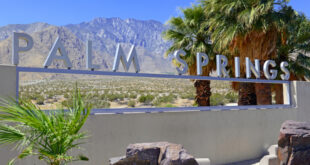Actually a very big park. Ontario Great Park will cover 370 acres and stretch 3.5 miles, as its currently planned. The project will take decades to complete, but development of the first phase could start next year.
Ontario is working on a 370-acre project that won’t include one square foot of industrial development.
Rather, it will be for recreation, entertainment and community gatherings, and will be one of the largest city-developed parks in California, if not the United States, when it’s completed.
The proposed Ontario Great Park will extend for three and a half miles, east to west, from Haven Avenue to Campus Avenue, with widths that would range from 280 to 1,600 feet, according to a staff report.
The park, which will be twice the size San Bernardino County’s Cucamonga-Guasti Park in Ontario, will run approximately between Ontario Ranch and Eucalyptus avenues. It will be surrounded by residential and mixed-use land uses to its north and south.
Great Park is “a large and ambitious” development that has the potential to transform all of Ontario and greatly improve the city’s quality of life, according to Planning Director Rudy Zeledon.
“You can compare it to Central Park in New York, although it’s not nearly as big,” Zeledon said. “The goal is to build something that will grow and develop along with the city.”
In January, the city council approved preliminary plans for Great Park’s first phase. Those plans were put together by SWA Group, a planning and urban design firm in Laguna Beach hired by Ontario.
Great Park – the project’s working name – will be developed on land zoned for park use that Ontario annexed from San Bernardino County in 1997, land that was part of the Chino Agricultural Preserve. That property was occupied mostly by dairy farms and still contains a few farmhouses and a nursery, according to a staff report.
Great Park’s first phase will cover 130 acres. It will be bordered by Grand Park Street to the north, Eucalyptus Avenue to the south, Haven Avenue to the east and Archibald Avenue to the west.
Great Park’s first phase will include primary and secondary trails that will link different parts of the park and with the outside community. It will feature Market Alley where farmer’s markets, food trucks and community events will be held.
First phase plans also call for a community barn, a children’s playground called Kids Corral, picnic spaces and a 3,000-seat amphitheater alongside the park’s central plaza. A 12-foot wide asphalt trail for walkers, joggers and bicyclists will traverse Great Park, as will a dry creek to collect rainwater.
Today, Ontario has close to 600 acres of park space made up of 25 community parks, neighborhood parks, golf courses and the regional Cucamonga-Guasti Park.
Great Park is expected to cost about $100 million – paid for mostly with developer fees – and take several decades to complete. Cost of the first phase will be about $45 million.
Residents of Ontario Ranch are expected to be among Great Park’s primary patrons.
A master-planned community being developed immediately west of Interstate 15 and south of the 60 Freeway, Ontario Ranch will cover 8,000 acres and have 50,000-plus residential units when it’s finished, probably around 2050, Zeledon said.
The project formerly known as New Model Colony will also have more than 15.5 million square feet of commercial and office development and 20 million square feet of industrial development at buildout, according to the report.
Ontario officials have been considering developing a large park in Ontario for about 10 years, Councilman Alan Wapner said.
“Because it’s going to be so big, we might have a problem getting people in other parts of the city to use it,” Wapner said. “We have to get the word out that this park is for everyone. It belongs to the whole city.”
Work on the first phase could start in the fourth quarter of 2023, Wapner said.
“I like the idea of building a bigger park because those [smaller] parks we’ve developed in the past are too hard to police,” Wapner said. “The Great Park will serve more people, and it will attract more development because the developers will be able top use it in their marketing.”
Besides helping to provide clean air and improve public health, public parks can make local economies stronger and create jobs, according to the City Parks Alliance, a nationwide group of urban parks administrators and advocates based in Washington D.C.
“Parks attract residents and businesses, increase revenue for cities, spur private investment and increase job opportunities,” the alliance’s website states. “In Denver, $1.2 million in federal park grants resulted in over $2.5 billion in local public and private investments.
Although Ontario and New York are about 2,400 miles apart, comparing Great Park to 843-acre Central Park is not far-fetched, said Sean O’Malley, managing principal with SWA.
“Central Park was on the outskirts of New York City when it was built in the 1850s, but the city developed and grew up around it,” O’Malley said during a community workshop in June 2021. “We plan to do the same thing with Great Park Ontario.”
 IE Business Daily Business news for the Inland Empire.
IE Business Daily Business news for the Inland Empire.



When will construction begin on this project?